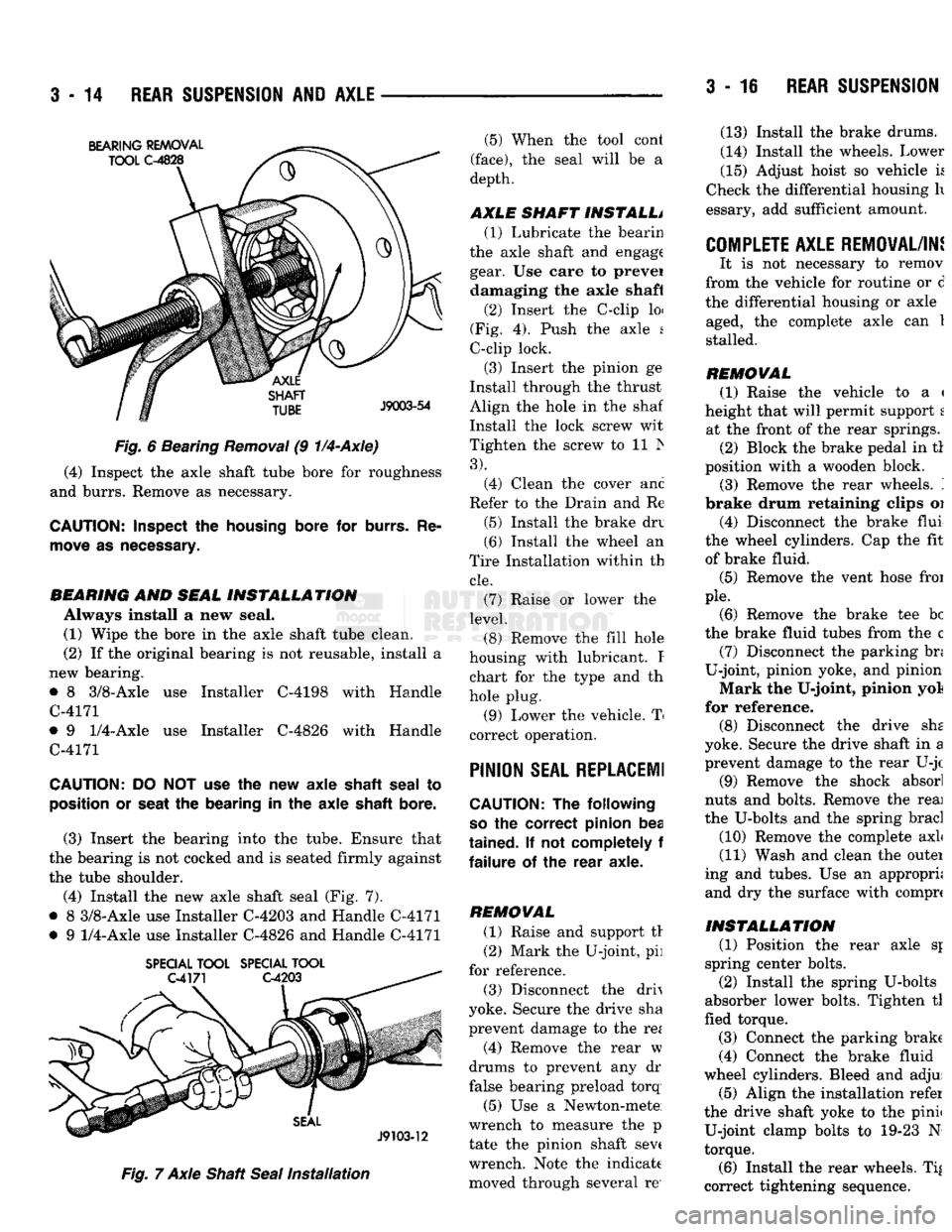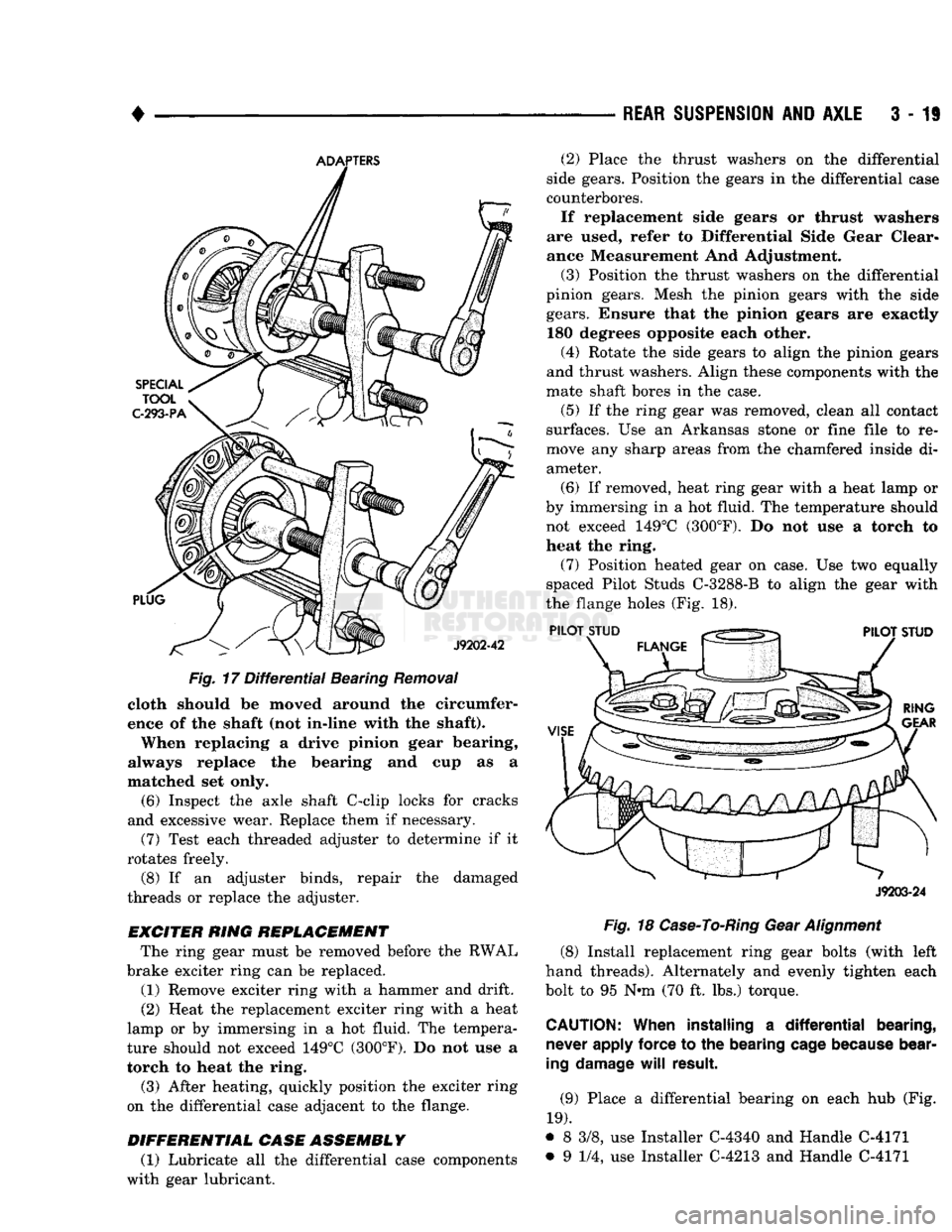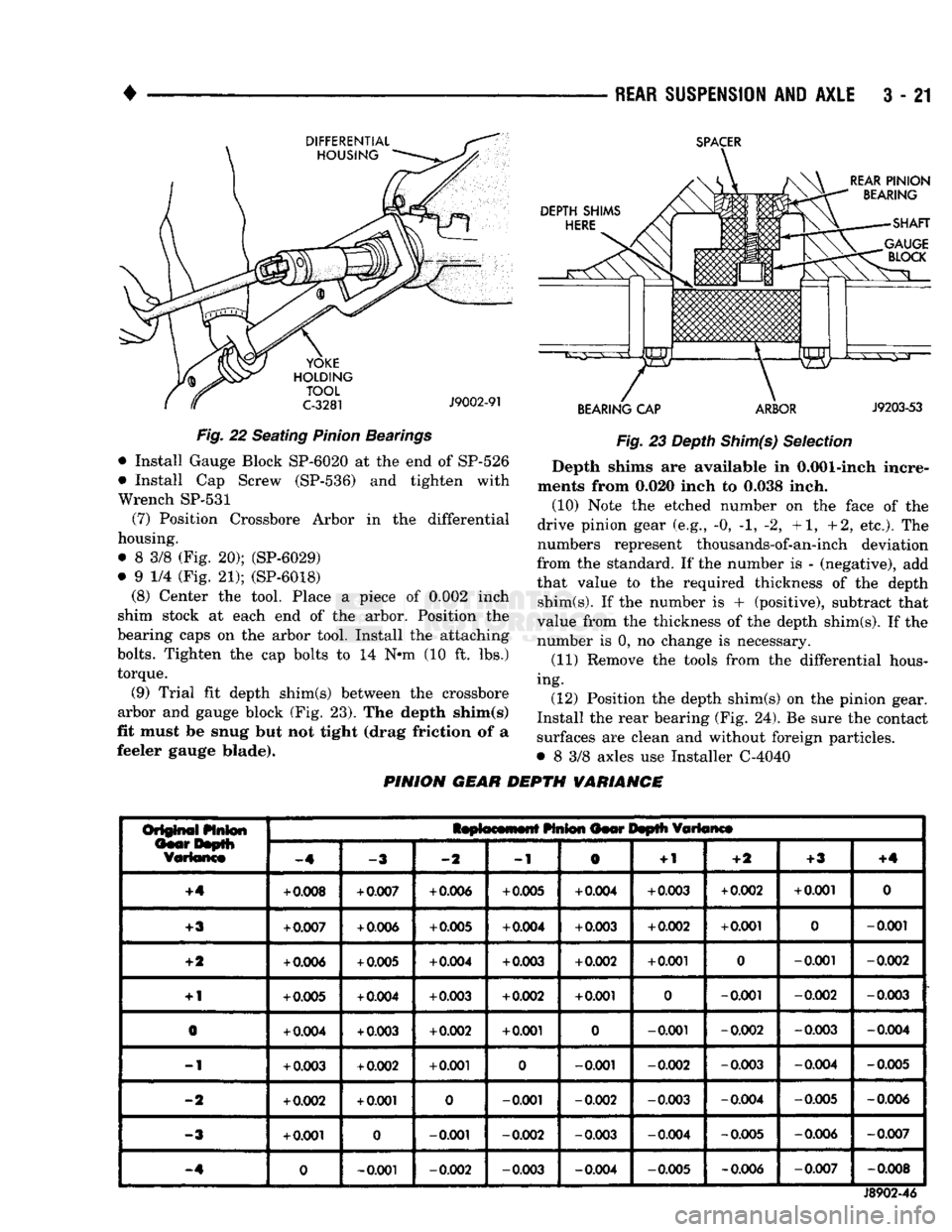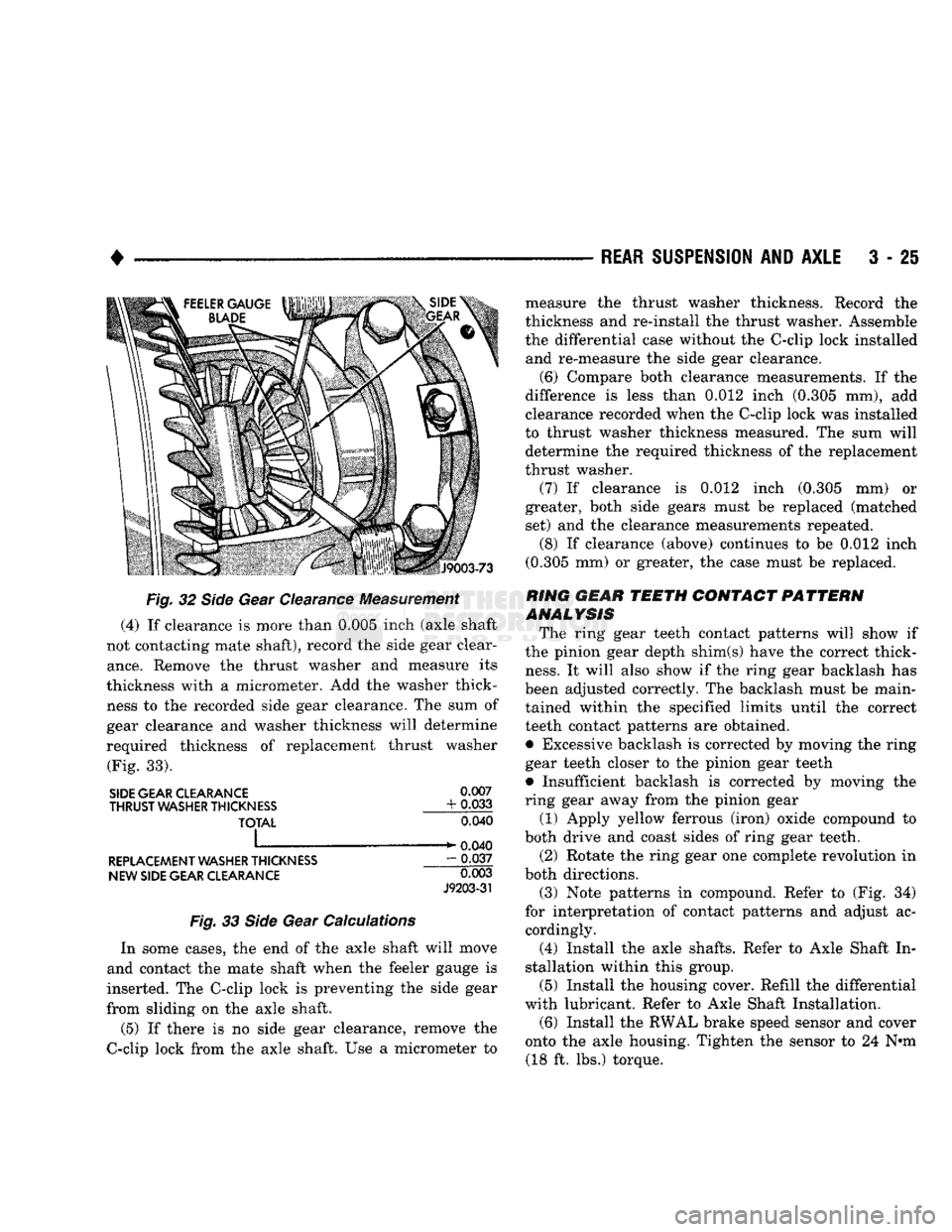1993 DODGE TRUCK torque
[x] Cancel search: torquePage 143 of 1502

3
- 14
REAR SUSPENSION
AND
AXLE
3
- 18
REAR SUSPENSION Fig.
6 Bearing
Removal
(9
1/4-Axle)
(4) Inspect the axle shaft tube bore for roughness
and burrs. Remove as necessary.
CAUTION:
Inspect
the
housing
bore for
burrs.
Re
move
as
necessary.
BEARING
AND
SEAL
INSTALLATION
Always install a new seal. (1) Wipe the bore in the axle shaft tube clean.
(2) If the original bearing is not reusable, install a
new bearing.
• 8 3/8-Axle use Installer C-4198 with Handle
C-4171
• 9
1/4-Axle
use Installer C-4826 with Handle
C-4171
CAUTION:
DO NOT use the new axle
shaft
seal
to
position
or
seat
the bearing in the axle
shaft
bore.
(3) Insert the bearing into the tube. Ensure that
the bearing is not cocked and is seated firmly against
the tube shoulder.
(4) Install the new axle shaft seal (Fig. 7).
• 8 3/8-Axle use Installer C-4203 and Handle C-4171
• 9
1/4-Axle
use Installer C-4826 and Handle C-4171
SPECIAL
TOOL
SPECIAL
TOOL
Fig.
7 Axle Shaft
Seal
Installation
(5) When the tool cont
(face),
the seal will be a
depth.
AXLE SHAFT INSTALL* (1) Lubricate the bearin
the axle shaft and engage gear. Use care to prevei damaging the axle shaft
(2) Insert the C-clip loi
(Fig. 4). Push the axle s
C-clip lock.
(3) Insert the pinion ge
Install through the thrust
Align the hole in the shaf
Install the lock screw wit
Tighten the screw to 11 Is
3).
(4) Clean the cover anc
Refer to the Drain and Re
(5) Install the brake drv
(6) Install the wheel an
Tire Installation within th
cle.
(7) Raise or lower the
level.
(8) Remove the fill hole
housing with lubricant. I chart for the type and th
hole plug.
(9) Lower the vehicle. T
correct operation.
PINION
SEAL REPLACE!!
CAUTION:
The following
so
the correct pinion bea
tained.
If not completely f
failure
of the rear axle.
REMOVAL (1) Raise and support tr
(2) Mark the U-joint, pi]
for reference.
(3) Disconnect the drh
yoke. Secure the drive sha
prevent damage to the re*
(4) Remove the rear w
drums to prevent any dr
false bearing preload torq
(5) Use a Newton-mete
wrench to measure the p
tate the pinion shaft sev( wrench. Note the indicate moved through several re' (13) Install the brake drums.
(14) Install the wheels. Lower
(15) Adjust hoist so vehicle k
Check the differential housing h
essary, add sufficient amount.
COMPLETE AXLE REMOVAL/IN!
It is not necessary to remov
from the vehicle for routine or d
the differential housing or axle aged, the complete axle can 1
stalled.
REMOVAL (1) Raise the vehicle to a <
height that will permit support t at the front of the rear springs. (2) Block the brake pedal in tl
position with a wooden block. (3) Remove the rear wheels. '.
brake drum retaining clips oi
(4) Disconnect the brake flui
the wheel cylinders. Cap the fit of brake fluid.
(5) Remove the vent hose froi
pie.
(6) Remove the brake tee be
the brake fluid tubes from the c (7) Disconnect the parking bn
U-joint, pinion yoke, and pinion
Mark the U-joint, pinion yol
for reference. (8) Disconnect the drive she
yoke. Secure the drive shaft in a prevent damage to the rear U-jc
(9) Remove the shock absorl
nuts and bolts. Remove the reai
the U-bolts and the spring brad
(10) Remove the complete axL
(11) Wash and clean the outei
ing and tubes. Use an appropri; and dry the surface with comprc
INSTALLATION
(1) Position the rear axle sj
spring center bolts.
(2) Install the spring U-bolts
absorber lower bolts. Tighten tl
fled torque.
(3) Connect the parking brake
(4) Connect the brake fluid
wheel cylinders. Bleed and adjui (5) Align the installation refer
the drive shaft yoke to the pinii U-joint clamp bolts to 19-23 N
torque.
(6) Install the rear wheels. Ti|
correct tightening sequence.
Page 146 of 1502

•
REAR
SUSPENSION
AND
AXLE
3 - 11
ADAPTERS
Fig.
17
Differential
Bearing
Removal
cloth should be moved around the circumfer
ence of the shaft (not in-line with the shaft).
When replacing a drive pinion gear bearing,
always replace the bearing and cup as a
matched set only.
(6) Inspect the axle shaft C-clip locks for cracks
and excessive wear. Replace them if necessary.
(7) Test each threaded adjuster to determine if it
rotates freely. (8) If an adjuster binds, repair the damaged
threads or replace the adjuster.
EXCITER
RING
REPLACEMENT
The ring gear must be removed before the RWAL
brake exciter ring can be replaced.
(1) Remove exciter ring with a hammer and drift.
(2) Heat the replacement exciter ring with a heat
lamp or by immersing in a hot fluid. The tempera
ture should not exceed 149°C (300°F). Do not use a
torch to heat the ring.
(3) After heating, quickly position the exciter ring
on the differential case adjacent to the flange.
DIFFERENTIAL
CASE ASSEMBLY
(1) Lubricate all the differential case components
with gear lubricant. (2) Place the thrust washers on the differential
side gears. Position the gears in the differential case
counterbores.
If replacement side gears or thrust washers
are used, refer to Differential Side Gear Clear ance Measurement And Adjustment.
(3) Position the thrust washers on the differential
pinion gears. Mesh the pinion gears with the side
gears.
Ensure that the pinion gears are exactly 180 degrees opposite each other.
(4) Rotate the side gears to align the pinion gears
and thrust washers. Align these components with the
mate shaft bores in the case.
(5) If the ring gear was removed, clean all contact
surfaces. Use an Arkansas stone or fine file to re
move any sharp areas from the chamfered inside di ameter.
(6) If removed, heat ring gear with a heat lamp or
by immersing in a hot fluid. The temperature should not exceed 149°C (300°F). Do not use a torch to
heat the ring.
(7) Position heated gear on case. Use two equally
spaced Pilot Studs C-3288-B to align the gear with
the flange holes (Fig. 18).
J9203-24
Fig.
18
Case-To-Ring
Gear
Alignment
(8) Install replacement ring gear bolts (with left
hand threads). Alternately and evenly tighten each
bolt to 95 N-m (70 ft. lbs.) torque.
CAUTION:
When
installing a
differential
bearing,
never apply force to the bearing
cage
because
bear
ing
damage
will
result.
(9) Place a differential bearing on each hub (Fig.
19).
• 8 3/8, use Installer C-4340 and Handle C-4171
• 9 1/4, use Installer C-4213 and Handle C-4171
Page 147 of 1502

3
- 20
REAR SUSPENSION
AND
AXLE
•
SPECIAL
TOOL
C-4171
SPECIAL
TOOL
8-3/8-
C-4340
9.1/4-
C-4213
J9203-33
Fig.
19 Differential Bearing Installation
PINION DEPTH MEASUREMENT AND ADJUSTMENT
WITH
GAUGE SET
(1) Use pinion gear adjustment gauge set and con
tinue the assembly: • 8 3/8, use C-3715-B (Fig. 20)
• 9 1/4, use C-758-D6 (Fig. 21) (2) Install front (outer) bearing cup use Installer
D-130 and Handle C-4171. (3) Install rear (inner) bearing cup.
• 8 3/8 axles, use Installer C-4308 and Handle C-4171
• 9 1/4 axles, use Installer C-4310 and Handle C-4171 8 3/8 axles assemble C-3715-B Tool Set as de
scribed (Fig. 20);
SPECIAL
TOOL
SET
G3715-B
SP-6030
SP-536—
SP-531
J9203-51
Fig.
20 8 3/8 Axle
Pinion
Adjustment Tools
• Position Spacer (SP-6030) over Shaft (SP-5385) • Position pinion rear bearing on shaft
• Position tools (with bearing) in the housing
• Install Sleeve (SP-5382)
• Install pinion front bearing
• Install Spacer (SP-6022)
• Install Sleeve (SP-3194-B), Washer (SP-534) and
Nut (SP-3193) 9 1/4 axles assemble C-758-D6 Tool Set as de
scribed (Fig. 21);
SPECIAL TOOL C-758-D6
SP-6018
SP-536-*-
21 9 1/4 Axle
Pinion
Adjustment Tools and • Position Spacer (SP-6017) over Shaft (SP-526)
• Position pinion rear bearing on shaft
• Position tools (with bearing) in the housing
• Install Sleeve (SP-1730)
• Install pinion front bearing
• Install Spacer (SP-6022)
• Install Sleeve (SP-535-A), Washer (SP-534)
Nut (SP-533) (4) Prevent compression sleeve tool from turning
with Wrench C-3281.
Tighten the nut to seat the pinion bearings in the
housing (Fig. 22). Allow the sleeve to turn several
times during the tightening to prevent brinelling the
bearing cups or the bearings.
Depth shim(s) are positioned between the pin
ion gear rear bearing and pinion gear to provide the separation distance. The required thickness
of the depth shim(s) is determined according to
the following information. (5) Loosen the compression nut tool. Lubricate the
pinion gear front and rear bearings with gear lubri cant. Re-tighten the compression nut tool to 1-3 N*m (15-25 in. lbs.) torque. Rotate the pinion gear several
complete revolutions to align the bearing rollers. (6) Install Gauge Block.
• 8 3/8 axles (Fig. 20)
• Install Gauge Block SP-5383 at the end of SP-5385
• Install Cap Screw (SP-536) and tighten with
Wrench SP-531 • 9 1/4 axles (Fig. 21)
Page 148 of 1502

•
REAR SUSPENSION
AND
AXLE
3 - 21
Fig.
22 Seating Pinion
Bearings
• Install Gauge Block SP-6020 at the end of SP-526
• Install Cap Screw (SP-536) and tighten with
Wrench SP-531
(7) Position Crossbore Arbor in the differential
housing.
• 8 3/8 (Fig. 20); (SP-6029)
• 9 1/4 (Fig. 21); (SP-6018)
(8) Center the tool. Place a piece of 0.002 inch
shim stock at each end of the arbor. Position the
bearing caps on the arbor tool. Install the attaching
bolts.
Tighten the cap bolts to 14 N*m (10 ft. lbs.) torque.
(9) Trial fit depth shim(s) between the crossbore
arbor and gauge block (Fig. 23). The depth shim(s)
fit must be snug but not tight (drag friction of a
feeler gauge blade).
SPACER
BEARING
CAP
ARBOR
J9203-53 Fig.
23 Depth
Shim(s)
Selection Depth shims are available in 0.001-inch incre
ments from 0.020 inch to 0.038 inch. (10) Note the etched number on the face of the
drive pinion gear (e.g., -0, -1, -2, +1, +2, etc.). The
numbers represent thousands-of-an-inch deviation
from the standard. If the number is - (negative), add
that value to the required thickness of the depth shim(s). If the number is + (positive), subtract that
value from the thickness of the depth shim(s). If the
number is 0, no change is necessary.
(11) Remove the tools from the differential hous
ing. (12) Position the depth shim(s) on the pinion gear.
Install the rear bearing (Fig. 24). Be sure the contact surfaces are clean and without foreign particles.
• 8 3/8 axles use Installer C-4040
PINION GEAR DEPTH
VARIANCE
Original Pinion
Gear
Depth Variance
Replacement
Pinion Gear Depth Variance
Original Pinion
Gear
Depth Variance
-4
-3
-2
-1
0
+
1
+2
+3 +4
+4
+0.008
+
0.007
+
0.006
+
0.005
+
0.004
+
0.003
+
0.002
+
0.001
0
+3
+
0.007
+
0.006
+
0.005 +0.004
+0.003
+
0.002
+
0.001
0
-0.001
+2
+
0.006
+
0.005
+
0.004
+
0.003 +0.002
+
0.001
0
-0.001
-0.002
+ 1
+
0.005
+
0.004
+
0.003 +0.002
+
0.001
0
-0.001 -0.002
-0.003
0
+0.004
+
0.003
+
0.002
+
0.001
0
-0.001
-0.002 -0.003
-0.004
-1
+
0.003
+
0.002
+
0.001
0
-0001 -0.002 -0.003 -0.004
-0.005
-2
+
0.002
+
0,001
0
-0.001 -0.002
-0.003 -0.004
-0.005 -0.006
-3
+
0.001
0
-0.001 -0.002
-0.003 -0.004 -0.005 -0.006
-0.007
-4
0 -
0.001 -0.002
-0.003 -0.004
-0.005 -0,006
-0.007
-0.008
J8902-46
Page 149 of 1502

3
- 22
REAR
SUSPENSION
AND
AXLE
• 9 1/4 axles use Installer C-3095
Fig.
24 Shaft Rear Bearing
Installation
(13) Lubricate the pinion gear front and rear bear
ings with gear lubricant.
(14) Install the pinion gear in the housing. Install
the new collapsible spacer at the end of the pinion gear. Install the pinion gear front bearing.
(15) Install the pinion yoke with Remover/Installer
C-3718 and Wrench C-3281 (Fig. 23).
It is necessary to use the tools (above) to cor
rectly seat the front bearing on the drive pinion gear shaft (Fig. 25).
CAUTION:
Use
care
to
prevent collapsing preload
collapsible
spacer during installation
of the
yoke
and
seating
the
front bearing.
(16) Remove yoke and tools from the pinion gear.
(17) Install the new pinion gear shaft seal (Fig.
26).
• 8 3/8-inch diameter use Seal Installer C-4076-A and Handle C-4735-1
• 9
1/4-inch
diameter use Seal Installer C-3980-A or C-4109-A and Handle C-4735 The seal is correctly installed when the seal
flange contacts the face of the differential hous
ing flange.
The outer perimeter of the seal is pre-coated
with a special sealant. An additional application of sealant is not required. (18) Install the pinion yoke with Remover/Installer
C-3718 and Wrench C-3281.
(19) Remove the tools. Install the Belleville
washer. The convex side of the washer must face out ward. Install the pinion nut. 4
J9103-21
Fig.
25
Pinion
Yoke
Installation
Fig.
26
Pinion
Gear
Seal
Installation
(20) Retain pinion yoke with Wrench C-3281. Ini
tially tighten the drive pinion gear shaft nut enough
to remove the bearing end play. While tightening, ro
tate the pinion shaft to ensure the bearing rollers are correctly seated. (21) Tighten the pinion nut to (Fig. 27) 285 N*m
(210 ft. lbs.) torque (minimum). (22) Remove the tools from the shaft. Rotate the
pinion several complete revolutions (both directions)
to additionally seat the bearing rollers.
CAUTION:
Never loosen
the
pinion gear
nut to de
crease
the
pinion gear bearing preload torque.
If the
specified preload torque
is
exceeded,
a
replacement
collapsible
spacer must
be
installed.
The
torque
se
quence
will
have
to be
repeated.
SPECIAL
DIFFERENTIAL
TOOL
HOUSING
Page 150 of 1502

•
REAR SUSPENSION
AND
AXLE
3 - 23
Fig. 27 Tightening Pinion Gear Nut (23) Measure the pinion bearing preload torque by
rotating pinion shaft with a Newton-meter or an inch-pound torque wrench. The correct bearing preload torque is 2-4 N-m (20-30 in. lbs.). This torque
value is with replacement bearings and pinion nut
tightened to a minimum of 285 N-m (210 ft. lbs.)
torque (Fig. 28).
When using original pinion rear bearing and a
replacement front bearing. The correct preload torque is 1 N-m (10 in. lbs.) torque in addition to
the torque measured and recorded during disas sembly. Fig. 28 Bearing Preload Torque Measurement
The bearing preload torque should be constant
during a complete revolution of the drive pinion
gear shaft. If the preload torque varies during rotation of the shaft, there is an internal binding
that must be corrected before final assembly.
(24) If the specified torque is not obtained, tighten
the nut in small increments until the preload torque is obtained.
The differential will be unacceptable for use if
the final nut torque is less than 285 N-m (210 ft.
lbs.) torque. If the preload torque is not within the specified range this is also unacceptable.
DIFFERENTIAL CASE INSTALLATION (1) Apply a coating of hypoid gear lubricant to the
differential bearings, bearing cups and threaded ad
justers. A dab of grease can be used to keep the ad
justers in position. Carefully position the assembled differential case in the housing.
(2) Observe the reference marks and install the
differential bearing caps at their original locations (Fig. 29).
Fig.
29 Bearing
Caps
&
Bolts
(3) Install the bearing cap bolts (Fig. 29). Tighten
the upper bolts to 14 N-m (10 ft. lbs.) torque. Tighten the lower bolts finger-tight until the bolt head is lightly seated.
DIFFERENTIAL BEARING PRELOAD AND RING GEAR BACKLASH ADJUSTMENT The following must be considered when adjusting
bearing preload and gear backlash:
• The maximum ring gear backlash variation is
0.003 inch (0.076 mm)
• Mark the gears so the same teeth are meshed dur
ing all backlash measurements
• Maintain the torque while adjusting the bearing
preload and ring gear backlash • Excessive adjuster torque will introduce a high
bearing load and cause premature bearing failure. Insufficient adjuster torque can result in excessive differential case free-play and ring gear noise
Page 151 of 1502

3
- 24
REAR SUSPENSION
AND
AXLE
Fig.
30 Threaded Adjuster Tool
(2) Install Dial Indicator (Fig. 31). Position the
plunger against the drive side of a ring gear tooth. Measure the backlash at 4 positions (90 degrees apart) around the ring gear. Locate and mark the
area of minimum backlash.
(3) Rotate the ring gear to the position of the least
backlash. Mark the gear so that all future backlash
measurements will be taken with the same gear
teeth meshed.
(4) Loosen the right-side, tighten the left-side
threaded adjuster. Obtain backlash of 0.003 to 0.004
inch (0.076 to 0.102 mm) with each adjuster tight
ened to 14 N-m (10 ft. lbs.) torque. Seat the bearing
cups with the procedure described above.
(5) Tighten the differential bearing cap bolts;
• 8 3/8 axles to 95 N-m (70 ft. lbs.) torque
• 9 1/4 axles to 136 N-m (100 ft. lbs.) torque
(6) Use Wrench C-4164 to tighten the right-side
threaded adjuster to 102 N-m (75 ft. lbs.) torque. Seat the bearing cups with the procedure described above. •
Fig.
31
Ring
Gear
Backlash
Measurement Continue to tighten the right-side adjuster and seat
bearing cups until the torque remains constant at 102 N-m (75 ft. lbs.)
(7) Measure the ring gear backlash. The range of
backlash is 0.006 to 0.008 inch (0.15 to 0.203 mm).
Continue increasing the torque at the right-side
threaded adjuster until the specified backlash is ob tained.
The left-side threaded adjuster torque should
have approximately 102 N-m (75 ft. lbs.) torque. If the torque is considerably less, the complete adjustment procedure must be repeated. (8) Tighten the left-side threaded adjuster until
102 N-m (75 ft. lbs.) torque is indicated. Seat the
bearing rollers with the procedure described above. Do this until the torque remains constant. (9) Install the threaded adjuster locks . Ensure the
lock finger is engaged with the adjuster hole.
Tighten the lock screws to 10 N-m (90 in. lbs.) torque.
SIDE
GEAR CLEARANCE
MEASUREMENT
AND
ADJUSTMENT
When measuring side gear clearance, check each
gear independently. If it necessary to replace a side
gear, replace both gears as a matched set.
(1) Install the axle shafts and C-clip locks and pin
ion mate shaft. If necessary, refer to the installation
located within this group. (2) Measure each side gear clearance. Insert a
matched pair of feeler gauge blades between the gear
and differential housing on opposite sides of the hub (Fig. 32).
(3) If side gear clearances is no more than 0,005
inch. Determine if the shaft is contacting the pinion
gear mate shaft. Do not remove the feeler gauges,
inspect the axle shaft with the feeler gauge in serted behind the side gear. If the end of the axle
shaft is not contacting the pinion gear mate shaft,
the side gear clearance is acceptable.
• Insufficient adjuster torque will not support the
ring gear correctly and can cause excessive differen
tial case free-play and ring gear noise
The differential bearing cups will not always
immediately follow the threaded adjusters as they are moved during adjustment. Ensure accu
rate bearing cup responses to the adjustments. Maintain the gear teeth engaged (meshed) as
marked. The bearings must be seated by rapidly
rotating the pinion gear a half turn back and forth. Do this five to ten times each time the
threaded adjusters are adjusted.
(1) Use Wrench C-4164 to adjust each threaded ad
juster inward (Fig. 30). Adjust until the differential bearing free-play is eliminated. Allow some ring gear
backlash (approximately 0.01 inch/0.25 mm) between
the ring and pinion gear. Seat the bearing cups with
the procedure described above.
Page 152 of 1502

REAR
SUSPENSION
AND
AXLE
3 - 2§
Fig.
32
Side
Gear Clearance Measurement
(4)
If
clearance
is
more than 0.005 inch (axle shaft
not contacting mate shaft), record
the
side gear clear
ance.
Remove
the
thrust washer
and
measure
its
thickness with
a
micrometer.
Add the
washer thick ness
to the
recorded side gear clearance.
The sum of
gear clearance
and
washer thickness will determine
required thickness
of
replacement thrust washer (Fig.
33).
SIDE GEAR CLEARANCE
0.007
THRUST
WASHER THICKNESS
+ 0.033
TOTAL
0.040
I ^ ^ 0.040
REPLACEMENT WASHER THICKNESS
- 0.037
NEW SIDE GEAR CLEARANCE
0.003
J9203-31
Fig.
33
Side
Gear Calculations
In some cases,
the end of the
axle shaft will move
and contact
the
mate shaft when
the
feeler gauge
is
inserted.
The
C-clip lock
is
preventing
the
side gear
from sliding
on the
axle shaft.
(5)
If
there
is no
side gear clearance, remove
the
C-clip lock from
the
axle shaft.
Use a
micrometer
to
measure
the
thrust washer thickness. Record
the
thickness
and
re-install
the
thrust washer. Assemble
the differential case without
the
C-clip lock installed and re-measure
the
side gear clearance.
(6) Compare both clearance measurements.
If the
difference
is
less than
0,012
inch (0.305
mm), add
clearance recorded when
the
C-clip lock
was
installed
to thrust washer thickness measured.
The sum
will determine
the
required thickness
of the
replacement
thrust washer.
(7)
If
clearance
is 0.012
inch (0.305
mm) or
greater, both side gears must
be
replaced (matched set)
and the
clearance measurements repeated.
(8)
If
clearance (above) continues
to be 0.012
inch
(0.305
mm) or
greater,
the
case must
be
replaced.
RING
GEAR
TEETH CONTACT PATTERN
ANALYSIS
The ring gear teeth contact patterns will show
if
the pinion gear depth shim(s) have
the
correct thick
ness.
It
will also show
if the
ring gear backlash
has
been adjusted correctly.
The
backlash must
be
main tained within
the
specified limits until
the
correct
teeth contact patterns
are
obtained.
• Excessive backlash
is
corrected
by
moving
the
ring gear teeth closer
to the
pinion gear teeth
• Insufficient backlash
is
corrected
by
moving
the
ring gear away from
the
pinion gear
(1) Apply yellow ferrous (iron) oxide compound
to
both drive
and
coast sides
of
ring gear teeth. (2) Rotate
the
ring gear
one
complete revolution
in
both directions.
(3) Note patterns
in
compound. Refer
to (Fig. 34)
for interpretation
of
contact patterns
and
adjust
ac
cordingly.
(4) Install
the
axle shafts. Refer
to
Axle Shaft
In
stallation within this group. (5) Install
the
housing cover. Refill
the
differential
with lubricant. Refer
to
Axle Shaft Installation.
(6) Install
the
RWAL brake speed sensor
and
cover
onto
the
axle housing. Tighten
the
sensor
to 24 N*m
(18
ft. lbs.)
torque.